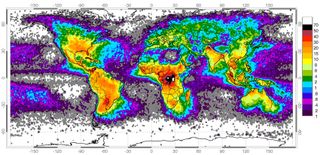
Lightning Detector System Tracks Storms in Western Africa

Storms are usually tracked with Doppler radar, but these systems are expensive and not available everywhere around the world, especially in developing countries. Guinea, a small country in western Africa, has started using a new, cheaper technique for charting weather: tracking flashes of lightning.
The system uses lightning as a proxy for storm intensity, and most recently used the method to track and issue an alert for a large thunderstorm that hammered western Guinea with rain and high winds on Oct. 22. The whole network consists of 12 lightning detectors placed atop mobile phone towers throughout the country, and was installed by the American company Earth Networks at a cost of US$1 million, according to Nature. A Doppler radar would cost about 10 times that much, Nature noted.
"With this project, we receive virtually real-time data throughout the entire country," Mamadou Lamine Bah, director of the lightning-tracking service, told Nature.
Email Douglas Main or follow him @Douglas_Main. Follow us @livescience, Facebook or Google+.
Sign up for the Live Science daily newsletter now
Get the world’s most fascinating discoveries delivered straight to your inbox.
Most Popular


